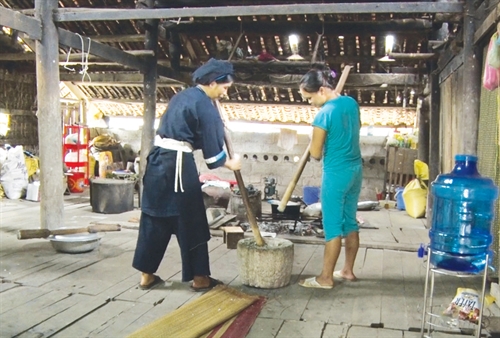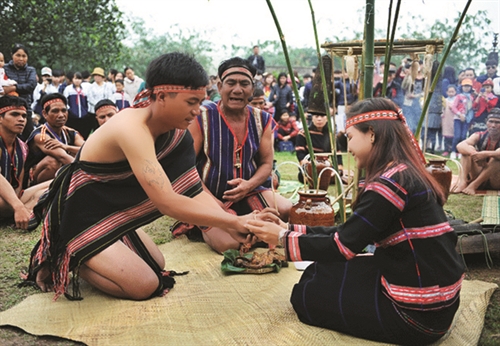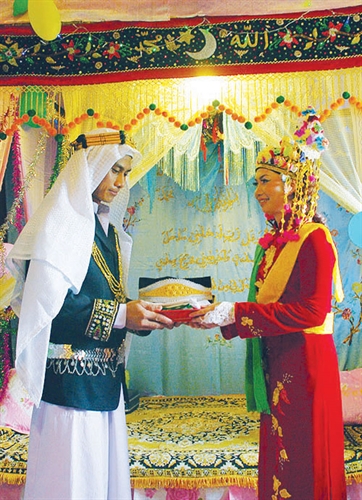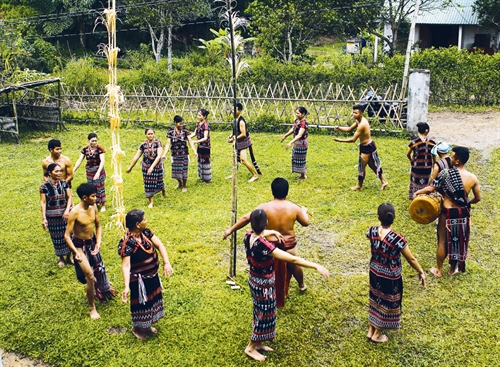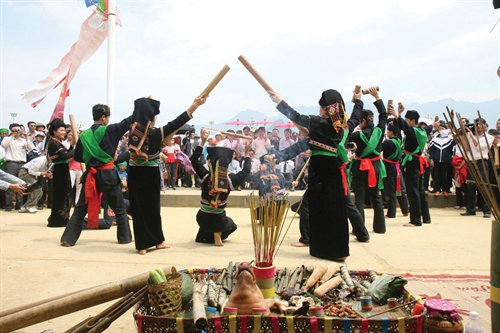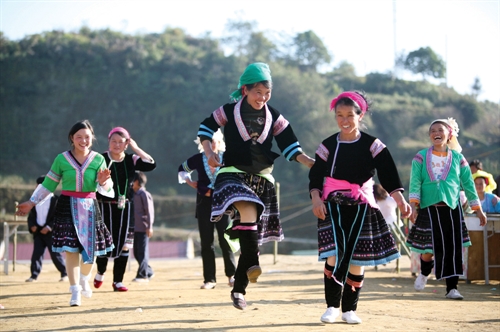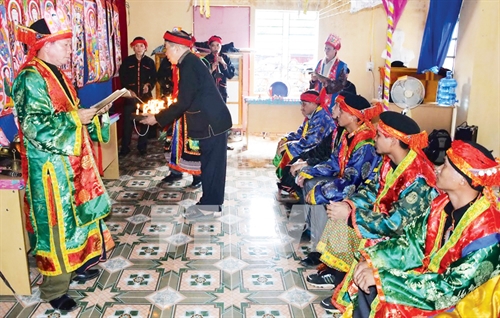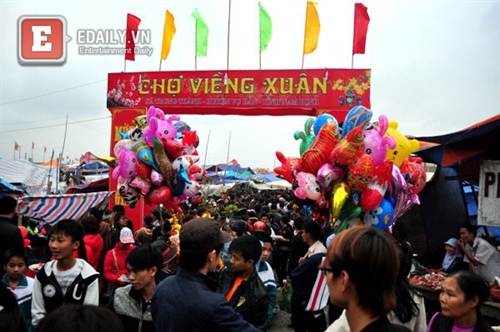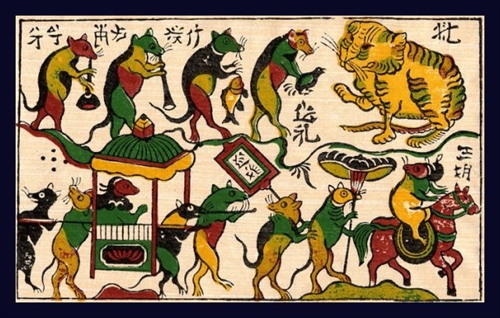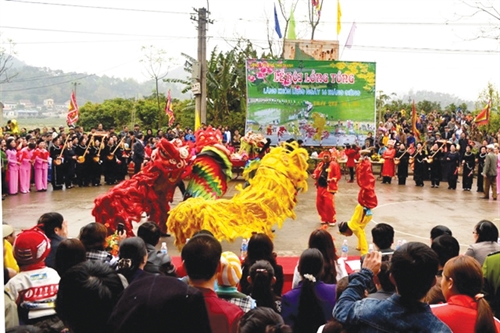Ta Thi Tam
Institute of Anthropology, Vietnam Academy of Social Sciences
The Dao Ho, also called Dao Quan Trang (Dao people in white trousers), is one of the nine sub-groups of Dao people residing mainly in Lao Cai, Yen Bai, Tuyen Quang and Ha Giang provinces. Dao Ho people often live in mountain valleys with an altitude of 100-150m above the sea level which is favorable for wet rice cultivation.
Dao Ho people live on farming, wet rice cultivation and animal rearing. They boast traditional crafts such as brocade weaving, forging, and making do - a kind of hand-made coarse paper.
Dao Ho lives in patriarchal families where the father as the family owner decides on the family affairs. It has five clans and each clan has a head who takes charge of general affairs of the clan and external affairs as well. A Dao Ho village - an economic, cultural and belief community - is managed by the village owner together with the village patriarch.
Water, called oam in Dao language, has a special role in the Dao Ho’s daily life, agriculture, important rituals and belief. In addition to rain water, called bung oam, other water sources for drinking are taken from underground, called oam plat tang li ben, and from rock fractures, called oam plat tang rau sat. Water is taken from rivers, streams, waterfalls, ditches and trenches for irrigation and production.
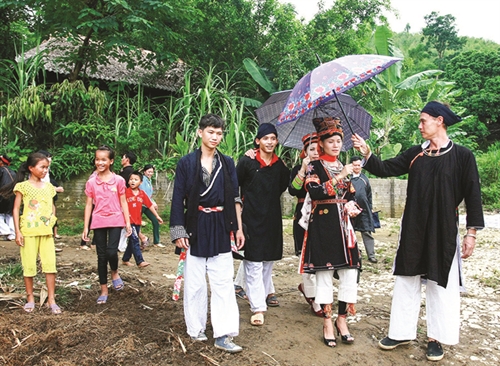 |
| The wedding of a Dao Quan Trang bride and a French groom__Photo: Internet |
Nowadays, almost all Dao Ho families access clean water via the systems of bamboo water gutters. Some Dao Ho families share a water gutter and apply a special method of water division. They use a water pipe made of a 30-40m long bamboo stem, connected with the head of water sources and supported by bamboo frames erected at intervals of 3-4m. Along the main pipe, four holes are pierced in four corners to be connected with four smaller bamboo stems. Each smaller bamboo stem is also pierced to make another four holes in different positions for water to run to individual families. As a result, a system of bamboo water pipes can bring water to all families living along the mountain side.
The Dao Ho offers water to the ancestors from the first to the fifteenth of the first, seventh and tenth lunar months. They often place one bamboo cylinder and three cups of water on the altar. On the floor, they place an incense burner and three cups of water for offering to three supreme gods, including Ngoc Thanh (governing the heaven), Thai Thanh (ruling the hell) and Thuong Thanh (ruling the earth). According to the Dao Ho’s belief, water witnesses everything happening in the worlds of the living and the dead and functions as a bridge connecting these two worlds and the heaven and the earth.
Buying water, called mai oam, from the water genie, called Long Vuong, on the first day of the first month of the new lunar year is an indispensable ritual for Dao Ho families. They believe that buying water from Long Vuong will bring good health to all family members and that those who come first to buy water will have the best luck.
To prepare such a ritual, on the 25th or 26th day of the last month of the old lunar year, the village patriarch mobilizes villagers to clean water bamboo pipes and replace the old ones and clean the areas around the head of water sources. In order to buy water from the water genie, in the past, Dao Ho family owners went to rock fractures at the head of water sources but nowadays they only have to go to the branch where the bamboo pipe is connected to bring water to their families.
The best time to buy water is between the 11p.m. of the last day of the old lunar year and 1a.m. of the first day of the new lunar year. During these two good hours, each family owner brings an incense stick, ghost money and a new large bamboo cylinder to buy water. Nowadays, some Dao Ho families use new bowls instead of bamboo cylinders. The bamboo cylinder or the bowl must be clean with no oil stains. The Dao Ho believes that if these objects are dirty or the family owner does not go to buy water, the family will have an unlucky year with poor crops and unhealthy family members and animals.
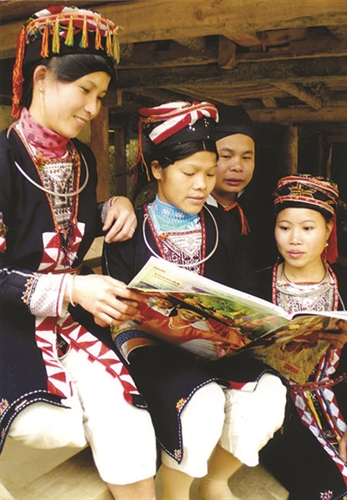 |
| The traditional costume of the Dao Quan Trang Photo: Internet |
At the branch where the bamboo pipe is connected for water to run to his family, the family owner pierces the incense stick through the ghost money and plants the burning stick on either the left or right side of the bamboo water pipe. He bows three times and prays to the water genie for clean water, health and free epidemics for family members, animals and plants during the year. He then brings the bamboo cylinder or the bowl full of water home, places it on the ancestor altar and informs his ancestors that he has bought water from the water genie for the family’s use for the whole year.
The Dao Ho has taboos for buying water or preserving water sources. They believe if the family’s bamboo water pipe is leaked or collapsed, the family will have an unhappy year and their gardens and fields will lack water during the whole year.
If a family owner meets a pregnant woman or a new mom, sees a snake or hears an owl’s screeching on his way to buy water, he will return home and choose another time to go. He must avoid stumbles to prevent water from being spilled over. He must also keep the water bought from the water genie out of reach of children or chicken, dogs or cats, otherwise the water genie will get angry and his family will have an unfortunate year.
From the first to the fifteen of the first month of the new lunar year, if the bamboo cylinder of water on the altar is not as full as it was taken home, it is believed that such year will see less rain and the family will have bad luck and quarrels.
Forests and water sources are two important criteria for the Dao Ho to set up their villages. All villages are surrounded by forests and have water sources and their houses have their back to the hills.
Dao Ho people think that destroying forests means destroying the water genie’s shelter and water sources. Hence, the sub-group has adopted many customary laws related to water source protection.
The Dao Ho never places their ancestor altars in parallel with the direction of the water flow. They are not allowed to freely release buffaloes and cows, discharge rubbish or wastewater or dump dead animals at the head of water sources, or to do digging near the water sources. It is prohibited for a family to discharge its wastewater into another’s or fight for water sources. Families whose buffaloes or cows destroy others’ bamboo water pipes must quickly repair the damaged pipes. Violators will be scolded by the village patriarch and other villagers or have to make an offering to the deities and invite representatives of all village families to the meal after the ritual.-
